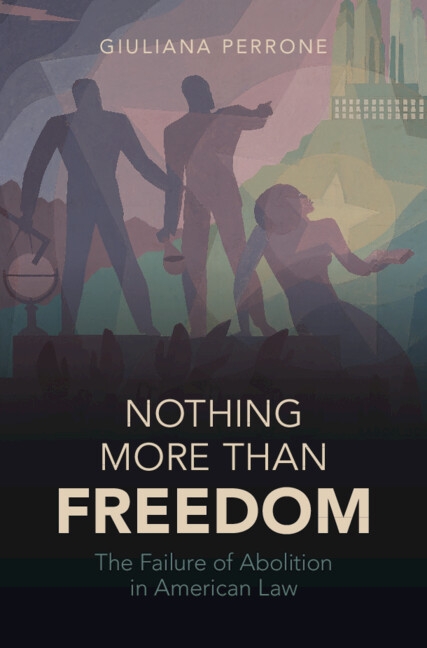
Freedom in the aftermath of slavery: historian Giuliana Perrone tracks the failures of American law
When did slavery end? The easy answer dates to 1865 and the newly ratified 13th Amendment to the United States Constitution. But according to historian Giuliana Perrone, it’s a trick question: “The short answer is it didn’t.”
While the 13th Amendment ended enslavement, followed three years later by the 14th Amendment’s guarantee of birthright citizenship, formerly enslaved people still lacked the tools to be equal citizens, explained Perrone, a UC Santa Barbara associate professor of history and author of a new book on the subject.
“Nothing More than Freedom: The Failure of Abolition in American Law” (Cambridge University Press, 2023) cites roughly 700 state and Supreme Court cases dating back to the mid-19th century. More than 150 years later, however, the trappings of slavery persist.
“There is a debate in the profession of historians about how presentist one should be,” Perrone said during a book discussion at UCSB’s Interdisciplinary Humanities Center. “I’m very firmly on the side that if your work speaks to things that occur in the present very obviously, don’t shy away from that. Embrace it. Which is what this book ultimately does, it speaks to the modern abolitionist movement, which is very focused on defects in criminal law and the prison industrial complex.”

The Current caught up with Perrone for more background on the project.
The Current: How did you arrive at the topic?
Giuliana Perrone: Originally, I thought I would become a historian of the 20th century, not the 19th. But while searching for a seminar topic on the earlier period, I stumbled across legal records about slavery that came from the Reconstruction Era, after slavery had supposedly ended. I wanted to know why so many cases about slavery existed after emancipation. No one I asked had an answer, so I decided I’d figure it out myself. It turns out that slavery didn’t totally end with emancipation; only enslavement ended. The institutional structures that supported slavery’s existence remained. As I argue in the book, emancipation took place but abolition has still not been fully achieved.
How have our laws failed Black Americans after abolition?
This is really challenging to answer because American law has failed nonwhite Americans in so many ways. At the most fundamental level, the basic civil rights of Black people were regularly violated. Despite citizenship enshrined in the 14th Amendment, states passed laws to prevent them from serving on juries or testifying against a white person, among others.
After the 15th Amendment extended suffrage to Black men, concerted efforts were undertaken to prevent them from exercising the right — that came in the form of laws that purposely restricted access — such as literacy tests and poll taxes — and in the form of extralegal violence used to intimidate and terrorize Black Americans who attempted to vote. The threat of truly horrific violence became a constant feature of Black life in the decades following the Civil War. State governments did nothing to stop it, and the federal government lost the ability to intervene thanks to a Supreme Court ruling.
These are the obvious big things. My book, though, focuses more on the less obvious ways that American law was insufficient to address the circumstances of those who had been formerly enslaved. For instance, because enslaved people could not legally marry, none of the children born to them were considered legitimate. Some attempts were made by legislatures and courts to address that, but in some instances, that illegitimacy had lasting effects. For example, some children of enslaved people were barred from inheriting from their parents, preventing the transfer of wealth from some parents to their children. Again, sometimes courts found ways around the illegitimacy problem, but in some states, they did not, and Black Americans paid the price.
Of the figures you wrote about, who was most important or inspiring and why?
Without a doubt, my favorite figure in the book is Cornelia Hart. Cornelia had been enslaved, but entered into a relationship with her enslaver, Ephraim Hart. They lived in Shreveport, Louisiana, as husband and wife and had several children. Assessing relationships between enslaved and enslaver is always challenging, but the archival record makes it clear that this couple chose to live openly as a family. Ephraim formally married Cornelia after emancipation, and he wrote a will leaving his entire estate to their children. However, when he died, his relatives contested the will, saying that they were the rightful heirs. They claimed that a formerly enslaved woman and their illegitimate children could not lawfully inherit despite their new status as U.S. citizens. Cornelia went to court to fight for her children’s inheritance. The family’s priest, doctors and neighbors testified on her behalf that the Harts were a loving family. She won her case and her children enjoyed their inheritance for generations.
Anything you'd like to add?
Abolition requires that we deconstruct slavery fully and replace it with the structures necessary for all Americans to equally enjoy basic dignity as well as the rights of citizenship. The key finding of my book is that the remnants of slavery remain embedded in areas of American law that we don’t expect, areas that don’t seem connected to the history of slavery at all. I hope that in pointing to some of these areas, we will be armed with more information to continue the process of abolition, to do the work of ridding American law and institutions of their ties to the slave past so that we can live up to the promises made during the Reconstruction Era: liberty, equal citizenship and full belonging in American society.

Giuliana Perrone
An associate professor in the Department of History, Perrone's research and teaching explores slavery and race in North America, socio-legal history and the Civil War and Reconstruction. She's particularly interested in how concepts of race have helped shape American political and legal identities and the ways in which courts have operated during times of crisis and radical transition.
Keith Hamm
Social Sciences, Humanities & Fine Arts Writer
keithhamm@ucsb.edu



